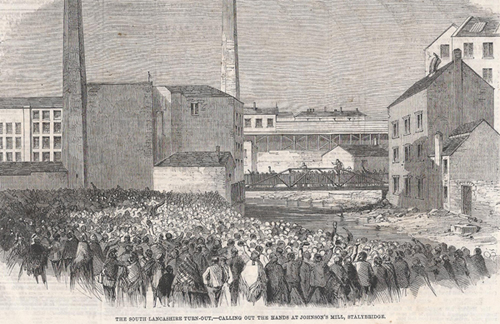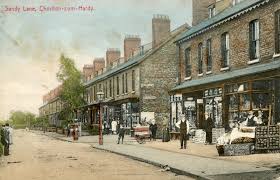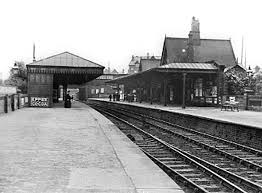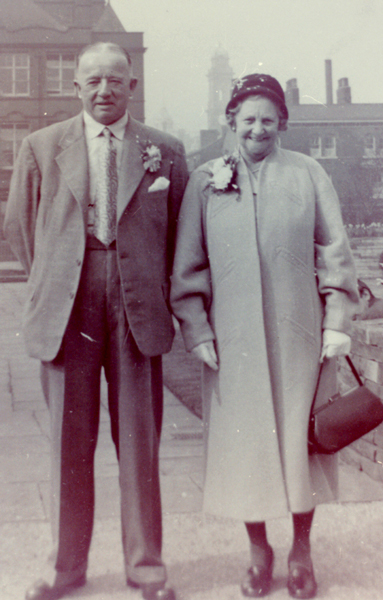 |
| Home | Manchester | London | Birmingham | USA | Australia | New Zealand | Buckinghamshire | Oxfordshire | Contact Peter |
Manchester
For the purposes of the website, Manchester includes parts of the conurbation often today described as Greater Manchester, ie., the city itself and the mill areas to the east and south east comprising the towns of Ashton under Lyne, Stalybridge and Dukinfield (All now in the Metropolitan Borough of Tameside, previously in the counties of Lancashire and Cheshire.) In addition to these are the nearby locations of Padfield and Glossop, both in Derbyshire, where ancestors lived. Although they were separate counties, in reality their places of residence were only a few miles apart.
Padfield
The first association with this distant region (from Buckinghamshire) came with the government sponsored migration of Richard Crowton in 1835 to work in the cotton mill of Benjamin Waterhouse in Padfield.
Migrants were offered transport and a guarantee of a job and housing. A wage of between 24 and 30 shillings per week for a family of between five or six was quite possible compared with perhaps seven shillings that an agricultural labourer might have to live on. The improved lifestyle very often encouraged other villagers or family members to follow suit and move north.
The 1899 O.S. map of Glossop shows the Hawkshead Mill where Richard Crowton went to work, to the north of the town, near the Union Workhouse, on what is now Hawkshead Road. Benjamin Waterhouse worked the Hawkshead Mill from 1830 to 1837 (With Robert Holland until 1831). The mill was lit by gas and it is perhaps not surprising that in 1837 the mill burnt down and with that event Waterhouse’s interest ceased.
His submission to the 1834 Factory Commission Inquiry showed that he employed children as young as nine years of age, working a twelve hour day. Poor behaviour could be punished by fining and expulsion. Those over eighteen years might work up to sixteen and a half hours. There was a half an hour break for breakfast, and an hour for lunch, when operative would often go home. Tea was usually brought to the factory for employees by a family member. Four hundred people were employed at the mill. The loss of the mill in 1837 along with the alternating periods of boom and recession in the cotton industry would have meant that the family worked in a number of the eight or nine other mills within walking distance. Today nothing is left of the original Hawkshead Mill.
This increasingly industrialised area was very different from the then rural backwater of Cuddington but although variable, there was in general good demand for labour and the quality of housing was likely to have been better than that available at the time in the isolated villages of Buckinghamshire. Although ultimately there was some movement away from the mills the growing families appear to have numerically flourished and descendants are still to be found in the area today.
The Family of Richard Crowton
Richard Crowton b. Cuddington,1792; m1. Elizabeth Roadnight, Cuddington 1815 (d. Hayfield, 1848) m2. Hannah 1850, Hayfield, d. 1871 aged 80 years, Hayfield
Census Returns
1841 : Padfield – Waterside Street
| Richard Crowton | 49yrs | Size maker | Not born in County |
| Elizabeth | 49 yrs | Not born in County | |
| Abraham | 21 yrs | Not born in County | |
| Ann | 19yrs | Not born in County | |
| Amos | 17 yrs | Not born in County | |
| Louisa | 13 yrs | Not born in County | |
| William | 11yrs | Not born in County | |
| Elizabeth | 9yrs | Not born in County |
1851 : Padfield – Waterside
| Richard Crowton | Head | Mar | 58yrs | Size maker | Cuddington,Bucks |
| Hannah | Wife | Mar | 62yrs | Hepworth, Yorks | |
| William | Son | Unm | 20yrs | Piecer | Cuddington,Bucks |
| Elizabeth | Dau | Unm | 19yrs | Twister in | Cuddington,Bucks |
| Amos Crowton | Head | Mar | 26yrs | Labourer | Buckingham |
| Ellen | Wife | Mar | 26yrs | Suffolk | |
| Ann | Dau | 4yrs | Labourer | Padfield | |
| Abraham | Son | 1mth | Scholar | Waterside |
Bross Croft
| Abraham Crowton | Head | Mar | 30yrs | Spinner | Cuddington,Bucks |
| Emma | Wife | Mar | 29yrs | Wheeler | Cuddington,Bucks |
1861 : Padfield – Yorkshire Row, Station Road
| Richard Crowton | Head | Mar | 68yrs | Dough maker | Cuddington,Bucks |
| Hannah | Wife | Mar | 73yrs | Housekeeper | Kirkburton,Yorks |
| Willam | Son | Unm | 30yrs | Railway Lab | Cuddington,Bucks |
.
Bross Croft Street
| Amos Crowton | Head | Mar | 36yrs | Cotton Spinner | Cuddington,Bucks |
| Hellener | Wife | Mar | 36yrs | Housekeeper | Eye,Suffolk |
| Ann | Dau | 14yrs | Cotton Weaver | Hadfield | |
| Jane | Dau | 8yrs | Scholar | Hadfield | |
| Jesse | Son | 6yrs | Scholar | Padfield | |
| Thomas | Son | 3yrs | Scholar | Padfield | |
| Elizabeth | Dau | 1yr | Scholar | Padfield | |
| George | Son | 3mths | Padfield | ||
| Lydia Sagar | Mother in law | 62yrs | Eye,Suffolk |
Bross Croft Street
| Abraham Crowton | Head | Mar | 40yrs | Cotton Spinner | Cuddington |
| Emma | Wife | Mar | 39yrs | Cotton Weaver | Cuddington |
1871 : Padfield – Bross Croft Street
| William Crowton | Head | Mar | 40yrs | Labourer | Cuddington |
| Elizabeth | Wife | Mar | 46yrs | Housekeeper | Oldfield,Yorks |
| Albert Ernest | Son | 6yrs | Scholar | Bross Croft |
1881 : Mottram
| William Crowton | Head | Mar | 50yrs | Plate Layer Railway | Cuddington |
| Elizabeth | Wife | Mar | 57yrs | Oldfield,Yorks | |
| Albert Ernest | Son | 16yrs | Pupil Teacher | Padfield |
1891 : Tintwistle – Tower Head (?)
| Robert Dawson | Head | Mar | ? | Farmer | ? |
| Hannah | Wife | Mar | 56yrs | ? | |
| Albert Ernest Crowton | Son in law | Mar | 26yrs | Insurance Agent | Glossop |
| Elizabeth | Dau | Mar | 26yrs | Dress Maker | Hollingworth |
| William | Boarder | Wid | 60yrs | Farm Lab | Cuddington |
1901 : Hadfield St.Andrew, Glossop – 115 Rain(?) Road (Next to Temple St.)
| Elizabeth Senior | Head | Widow | 68yrs | Cuddington | |
| William Crowton | Brother | Wid | 70yrs | Stone Quarryman | Cuddington |
1911 : Hollingworth – Woolley Mill
| Albert Ernest Crowton | Head | Mar | 46yrs | Nightwatchman (Calico Bleach Works) |
Hadfield |
| Elizabeth | Wife | Mar | 44yrs | Hollingworth | |
| William | Son | 18yrs | Clerk (CBW) | Tintwistle | |
| Hannah | Dau | 17yrs | Tintwistle | ||
| John | Son | 14yrs | Plaiter | Tintwistle | |
| Charles | Son | 10yrs | Scholar | Tintwistle | |
| William | Father | Wid | 80yrs | Retired Platelayer | Cuddington |
| Hannah Dawson | Mother in law | 76yrs |
Ashton Under Lyne (Dukinfleld and Staleybridge)
At about the same time that Richard and his family went to work in the cotton mills of Padfield, Robert (b. Cuddington, 1800) and Thomas (b. Cuddington, 1802) went to work in the cotton mills of Staleybridge, probably under a similar sponsorship scheme.
The type of location to which Robert and Thomas were moving can perhaps best be visualised by reference to Alan Rose in his book, 'Stalybridge and Dukinfield, Stalybridge and Dukinfield are children of the Industrial Revolution. The coming of a factory based cotton industry at the end of the eighteenth century transformed an area of scattered farmhouses and homesteads into coherent and self-confident towns. .......This mushroom growth took place on both sides of the River Tame, which from earliest times had divided Lancashire and Cheshire......The cotton mills and associated engineering works were concentrated along the River Tame, with the Huddersfield canal close by, and when the railway arrived in the mid nineteenth century, it followed much the same route.
'This disgusting filthy town' is how Friedrich Engels described Stalybridge in the 1840s and there is no indication that he would have been any more complimentary about Dukinfield. ........Stalybridge in particular became a byword for turbulence and unrest. In 1842, the men of Stalybridge were at the fore in the 'Plug Riots', an attempt to close down all the cotton mills by drawing the plugs of the steam boilers.
Staybridge was to witness the worst violence anywhere during the 'Cotton Famine' of the 1860s, when an angry mob smashed windows and stole food, at a time when almost every mill was either closed or on short time.
The manufacture of cotton and the mining of coal, which did so much to define these communities, are now past and gone....slum clearance, the need to provide more open road junctions and find space for car parks have opened up the central areas. There is now a blurring of the long-standing contrast between the bare open moors and the tightly packed streets around the mills.
The migrants from rural Buckinghamshire must have found the move north to be quite a culture shock. Fortunately there was family around and the certainty of employment and housing.
 Stalybridge Mill strikes, 1863
Stalybridge Mill strikes, 1863
Chorlton cum Hardy
Although the reasons for the move are less clear, there was further migration north when Charles Wesley CROTON, (b. Westminster, 1866) and son of John CROTON (b. Cuddington 1836) settled in Chorlton cum Hardy, Manchester in about 1890. John and his wife Elizabeth were working at the Wesleyan Training College, London in the 1860s and at the time of the 1871 Census John is listed as a coachman there. In 1881 they were lodging at 6 Mendora Road, Fulham, with John's occupation given as a carman. Ten years later they had returned to Oxford, where John worked for the Post Office in Aldgate as a caretaker. John died in 1897 at the John Radcliffe Hospital, whilst Elizabeth died ten years later in 1907. They were both members of the Wesleyan Methodist Church in New Inn Hall Street, Oxford.
It is still unknown what caused Charles to move north to Manchester but at the time of his marriage to Ann Preston at Oxford in 1886, she is recorded as being a resident of Greenheys, Manchester. He was resident in Littlemore and recorded as being a butcher. Here is a link with Manchester but how did they meet? He born in London and living in Oxford and she born in Cockermouth, Cumbria and living in Manchester? There first two children were born in Oxford but by 1890 they were in Manchester where Harold John was born. The 1891 Census shows that Charles Wesley was still working as a butcher but within quite a short period of time established himself as a hansom cab owner and eventually he purchased a motor cab and became well known in the Chorlton district of Manchester. He operated from a small holding on Sandy Lane, Chorlton which he tenented from the Egerton family of Tatton Park, Cheshire. He was famous in the locality for the noisy geese he kept. They apparently made a tremendous noise on anyones approach and were excellent at guarding the place. At this time Chorlton was still semi-rural and had not been totally enveloped by the ever growing city. Although most have now moved away, some of the descendants of Charles Wesley CROTON continue to live in the north of the city today, well over a hundred years after his first arrival.
 South side of Sandy Lane, Chorlton cum Hardy, c.1910
South side of Sandy Lane, Chorlton cum Hardy, c.1910
 West end of Sandy Lane, farmhouse of Charles Wesley Croton
West end of Sandy Lane, farmhouse of Charles Wesley Croton

Charles Wesley Croton, c.1900, with hansom cab in Chorlton cum Hardy

Chorlton cum Hardy Station, c. 1900
Chorlton Station was on the main line from Manchester Central to London St. Pancras and in it's day extremely busy with commutors. Charles Wesley was often to be found either dropping off or collecting passengers from the station. The station buildings have long since been demolished and it now has a much smaller platform and is part of the Manchester Metro System.

Chorlton National School, Chorlton Green, c. 1900. This is likely to be the school that Charles' children attended.
1911 Census Sandy Lane, Chorlton cum Hardy
| Charles Croton | Head |
Mar |
45 |
Cab Proprietor |
London |
| Ann | Wife |
Mar |
46 |
Cockermouth |
|
| Reginald | Son |
Unm |
22 |
Works for father |
Littlemore |
| Harold | Son |
Unm |
20 |
Electric Dept. M/c Corporation |
Manchester |
| Elizabeth | Dau |
Unm |
23 |
Shop Assistant |
Littlemore |
| Annie | Dau |
Unm |
18 |
Shop Assistant |
Manchester |
Charles Wesley Croton died in Manchester in 1926 at the relatively young age of 60 years. Reginald, as the eldest son, took over the family business, whilst Harold went on to take charge of a Manchester Corporation owned electricity station in the days before electricity supply was nationalised after the second World War. Harold retired early, having suffered a thrombosis and died in 1963. He regularly played crown green bowls and was a strong supporter of Manchester City Football Club, firstly watching them at Hyde Road and then at Maine Road following their move there in 1923. His wife Ellen (nee Goldsworthy) died in 1977.
 Reginald Croton, on left, c.1920, Chorlton station
Reginald Croton, on left, c.1920, Chorlton station
 Harold Croton and Ellen nee Goldsworthy, Manchester, 1955
Harold Croton and Ellen nee Goldsworthy, Manchester, 1955